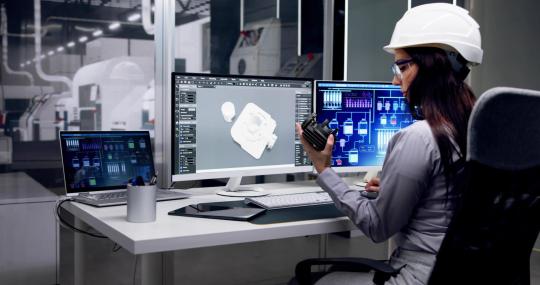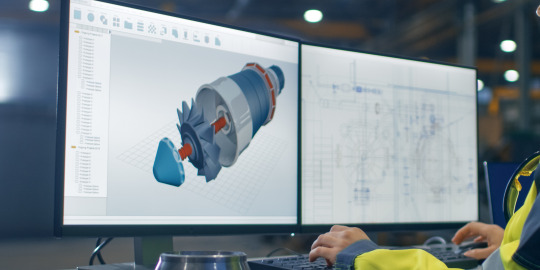#3d cad translation toolkit
Explore tagged Tumblr posts
Text
Optimizing Collaboration: The Advantages of CAD Data Exchange Through ProtoTech Solutions
Introduction
In today's rapidly evolving world, industries across the spectrum are constantly seeking innovative ways to streamline their processes, reduce costs, and enhance productivity. In the realm of engineering and manufacturing, Computer-Aided Design (CAD) plays a pivotal role in product development. However, the efficient exchange of CAD data between different software platforms and stakeholders can often be a daunting challenge. This is where ProtoTech Solutions steps in as a game-changer. In this blog, we will delve into the myriad benefits of CAD data exchange and explore how ProtoTech Solutions is revolutionizing this essential aspect of modern engineering.
Understanding CAD Data Exchange
CAD data exchange refers to the process of transferring computer-generated design data between different software systems, platforms, or stakeholders involved in the product development lifecycle. This data encompasses 3D models, 2D drawings, assembly information, metadata, and more. Effective CAD data exchange is crucial for seamless collaboration among designers, engineers, manufacturers, and other stakeholders, as it allows them to work with a common, up-to-date representation of the product.
The Challenges of CAD Data Exchange
Historically, CAD data exchange has been fraught with challenges. These include compatibility issues, format discrepancies, data loss, and a lack of standardization across software systems. These challenges can result in errors, delays, and increased costs during the product development process. ProtoTech Solutions recognized these challenges and set out to provide innovative solutions.
ProtoTech Solutions: Bridging the Gap
ProtoTech Solutions is a pioneering company that specializes in CAD data exchange solutions. With a mission to simplify the exchange of CAD data across different platforms and industries, ProtoTech Solutions has developed a range of cutting-edge software tools and services. Let's explore some of the key benefits they offer to users across various domains.
1. Enhanced Collaboration: ProtoTech Solutions' CAD data exchange solutions facilitate seamless collaboration among design teams, suppliers, manufacturers, and clients. Their tools ensure that everyone can access and work with the most up-to-date CAD data, reducing the risk of miscommunication and errors.
2. Format Flexibility: ProtoTech Solutions' software supports a wide range of CAD formats, including popular ones like STEP, IGES, STL, and more. This flexibility enables users to exchange data between different CAD systems, eliminating the need for time-consuming format conversions.
3. Data Integrity: Maintaining the integrity of CAD data is paramount. ProtoTech Solutions' solutions ensure that the transferred data retains its accuracy and completeness throughout the exchange process, preventing data loss and corruption.
4. Version Control: Keeping track of multiple versions of CAD models can be challenging. ProtoTech Solutions provides version control features, allowing users to manage revisions and changes efficiently.
5. Time and Cost Savings: By simplifying the CAD data exchange process, ProtoTech Solutions helps organizations save valuable time and reduce costs associated with manual data translation and rework.
6. Customization: ProtoTech Solutions' software can be tailored to meet the specific needs of different industries and applications. This level of customization ensures that users can adapt the tools to their unique workflows and requirements.
Conclusion
The benefits of CAD data exchange are clear: improved collaboration, reduced errors, and enhanced efficiency throughout the product development lifecycle. ProtoTech Solutions has emerged as a trusted partner in this endeavor, offering a range of innovative solutions that empower industries to overcome the challenges of CAD data exchange.
As technology continues to advance and industries become increasingly interconnected, the role of ProtoTech Solutions in simplifying CAD data exchange becomes even more critical. By investing in these solutions, organizations can unlock new levels of productivity, competitiveness, and innovation in their respective fields. It's safe to say that ProtoTech Solutions is at the forefront of transforming the way we exchange CAD data, making the future of product development brighter and more efficient than ever before.
#ProtoTech Solutions#CAD Data Exchange#3d cad conversion services#3d cad translation development#3d cad translation toolkit#cad interoperability toolkit#cad data translation sdk#cad data interoperability#cad data exchange software#cad translation development#cad data translation#cad data conversion#cad data exchange#cad data translation services
0 notes
Text
Unveiling The Power Of 3D Printing Design Software

Source – AnkerMake
In the realm of modern manufacturing and creativity, 3D printing has emerged as a transformative technology, enabling the fabrication of intricate objects with unprecedented precision and efficiency. At the heart of this revolution lies 3D printing design software, the digital toolkit that empowers designers, engineers, and enthusiasts to bring their visions to life in three-dimensional form. In this article, we explore the landscape of 3D printing design software, uncovering its capabilities, features, and the creative possibilities it unlocks.
Introduction to 3D Printing Software
Before diving into the intricacies of 3D printing software, it’s essential to understand its fundamental role in the 3D printing process. At its core, 3D printing design software serves as the bridge between the digital realm and the physical world, allowing users to create, modify, and optimize digital models that can be translated into physical objects through additive manufacturing.
From simple geometric shapes to complex assemblies, 3D printing design software accommodates a wide range of design requirements and skill levels, making it accessible to novices and experts alike. Whether you’re a hobbyist experimenting with DIY projects or a professional engineer developing prototypes for a new product, there’s a 3D printing design suite tailored to your needs.
Key Features and Functionality

Intuitive User Interface: A user-friendly interface with intuitive navigation tools and easy-to-understand commands is essential for beginners and experienced users alike.
Modeling Tools: Robust modeling tools for creating and manipulating 3D geometry, including tools for extrusion, lofting, sweeping, and sculpting.
Parametric Design: Parametric modeling capabilities that allow users to define geometric relationships and constraints, enabling rapid iteration and design optimization.
Support for Multiple File Formats: Compatibility with a wide range of file formats, including STL, OBJ, STEP, and IGES, to facilitate seamless collaboration and interoperability with other software applications.
Advanced Rendering and Visualization: High-quality rendering and visualization tools that allow users to create realistic renderings of their designs, helping to communicate ideas and concepts effectively.
Mesh Repair and Analysis: Built-in tools for repairing and analyzing mesh geometry to ensure watertight models suitable for 3D printing without errors or defects.
Integration with 3D Printing Hardware: Integration with 3D printing hardware and slicer software, allowing users to prepare models for printing directly within the design environment.
Popular 3D Printing Software
There is a plethora of 3D printing softwares available in the market, catering to different needs, preferences, and budgets. Some of the most popular 3D printing design software packages include:
Autodesk Fusion 360: A cloud-based CAD/CAM platform that offers a comprehensive set of design tools for mechanical engineering, industrial design, and product development.
Blender: A powerful open-source 3D modeling and animation software suite that is widely used by artists, designers, and animators for creating complex 3D models and visualizations.
SolidWorks: A professional-grade CAD software package known for its robust parametric modeling capabilities and extensive library of design features and tools.
Tinkercad: A beginner-friendly web-based 3D modeling software platform that is ideal for educators, students, and hobbyists looking to learn the basics of 3D design and printing.
Rhino: A versatile 3D modeling software package popular among architects, industrial designers, and jewelry designers for its flexible modeling tools and support for organic shapes.
SketchUp: An intuitive 3D modeling software package that is widely used by architects, interior designers, and hobbyists for creating detailed 3D models of buildings, furniture, and other objects.
Creative Applications and Use Cases

Art and Sculpture: Artists and sculptors are using 3D printing software to create intricate sculptures, installations, and mixed-media artworks that push the boundaries of creativity and expression.
Fashion and Wearable Technology: Designers are leveraging 3D printing software to create bespoke fashion accessories, jewelry, and wearable technology that blend cutting-edge design with functional innovation.
Healthcare and Biomedical Engineering: Researchers and medical professionals are harnessing the power of 3D printing design software to develop customized prosthetics, implants, and surgical guides that improve patient outcomes and quality of life.
Education and STEM Learning: Educators are integrating 3D printing software into STEM curricula to engage students in hands-on learning experiences and foster creativity, problem-solving, and critical thinking skills.
Future Trends and Developments
As technology continues to evolve and new advancements emerge, the landscape of 3D printing design is poised for further innovation and growth. Some of the key trends and developments shaping the future of 3D printing design include:

Cloud-Based Collaboration and Workflow Automation: Cloud-based collaboration tools and workflow automation solutions are streamlining the design process and facilitating real-time collaboration between remote teams, enabling faster iteration and design iteration.
Integration with Augmented Reality and Virtual Reality: Integration with augmented reality (AR) and virtual reality (VR) technologies is enabling designers to visualize and interact with 3D models in immersive virtual environments, enhancing the design review process and enabling more intuitive design exploration.
Moreover, 3D printing design software enables on-demand manufacturing, eliminating the need for costly inventory management and reducing the risk of overproduction and waste. By leveraging digital manufacturing technologies, companies can respond quickly to changing market demands and offer consumers a wider range of options for personalized products.
Conclusion
In conclusion, 3D printing design software is a powerful tool that is driving innovation and creativity across a wide range of industries and disciplines. From mechanical engineering to art and fashion, the capabilities of 3D printing software are virtually limitless, empowering individuals and organizations to bring their ideas to life in ways that were once unimaginable.
As technology continues to advance and new developments emerge, the future of 3D printing design promises to be even more exciting and transformative. Whether you’re a seasoned professional or a novice enthusiast, there has never been a better time to explore the world of 3D printing design and unleash your creativity on the digital frontier.
0 notes
Text
Transformative Changes in CAD Services for 2024
Let’s explore the evolving industry of construction,with a spotlight on the pivotal role of CAD Services in 2024. As architects and designers rely on CAD Services to translate real-world concepts into precise digital versions, it becomes more than a tool—it's a fundamental part of the design process. This guide simplifies the intricate world of CAD Services, exploring their practical applications and impact. Join us as we navigate the intersection where simplicity meets functionality, and witness how CAD Services shape the visual narratives unfolding on the digital canvas. This article is your guide to understanding the upcoming transformations in 2024 and why they matter. Along the way, we'll unravel the expanded Transformative Changes in CAD Services for 2024.

1. Understanding CAD Services:
Meet the unsung hero of our story—CAD Services. Think of it as a digital magician, turning real-world ideas into precise digital wonders. It's the magic wand for architects and designers, turning their visions into reality. As we step into 2024, CAD Services becomes the cornerstone, influencing and elevating the entire design process.
2. The Rise of BIM Services:
Now, let's talk about the exciting part—BIM Services. It's not just an upgrade; it's like moving from black and white to vibrant 3D with loads of information. This upgrade transforms teamwork and efficiency in design and construction. In 2024, the story unfolds, and BIM Services become the transformative force shaping the design landscape.
3. The Role of BIM Consulting Services:

Imagine BIM Consulting Services as your trusted guide on this design adventure. They're the experienced companion navigating the twists and turns of Building Information Modeling (BIM). With their insights, professionals not only use BIM Services efficiently but also achieve impressive project outcomes.
4. Streamlining with CAD and BIM:
Picture this as assembling a dream team—blending the strengths of traditional CAD Services with the dynamism of BIM Services. The result is a streamlined dance of design and construction, where errors fade away, collaboration thrives, and everything clicks into place effortlessly.
5. Real-world Applications:

Let’s bring it down to earth. Imagine businesses and professionals wielding the power of CAD Services and BIM Services as a dynamic duo. Projects flow seamlessly, teamwork hits its peak, and tasks get done at lightning speed. It's like having the most reliable toolkit, ensuring efficiency and precision in every project.
As we wrap up our article on the Transformative Changes in CAD Services for 2024, it's clear that a new design era is upon us. The simplicity and functionality these services bring to the table are game-changers for architects and designers alike.
In this ever-evolving industry, the choice of where to get your CAD Services matters. Geninfo Solutions stands out as a reliable partner in this journey. Their commitment to providing top-notch services ensures that you not only adapt to these changes seamlessly but also thrive in the world of modern design.
So, if you're looking to navigate the design frontier with confidence, consider trusting Geninfo Solutions for your CAD Services needs. Embrace the changes, embrace efficiency, and let your designs shine in this exciting era of 2024.
1 note
·
View note
Link
ProtoTech's CAD Translator can open, view, and query any 3D format. Try it now to streamline your workflow and improve collaboration. Compatible with various CAD software.
0 notes
Text
ProtoTech Solutions ~ TransMagic Collaboration

TransMagic, Inc., an industry leader in 3D CAD productivity tools, and ProtoTech Solutions, a custom software development company, have joined forces to bring the AEC and MCAD industries a series of translators that can effectively connect AEC and MCAD applications such as AutoCAD, Revit, Fusion 360, Max, and Solidworks.
Brief information about our translators on various CAD platforms:
STEP, JT, and Catia V5 Exporter for AutoCAD
STEP, JT, and Catia V5, IGES, Parasolid Exporter for Revit
STEP, Parasolid, Inventor Importer for Revit
And many more in the pipeline
How would the translators be helpful to the CAD community? Most translation efforts are focused on specific industries. This series of translators will serve the CAD community by bridging the gap between industries, where there is a great need for collaboration, for example where mechanical systems are included in civil and architectural designs. To addon, since CAD software is very expensive, having multiple of them is not feasible, having translators gives the advantage of translating files to the required format.
Statement from TransMagic “Using our intimate knowledge of 3D geometric data, TransMagic has created individual plugin translators to import and export 3D models from Revit and AutoCAD,” stated Todd Reade, CEO of TransMagic. “We are building strong data bridges between the primary mechanical design environments and the architectural world. Our intention is to make projects become more profitable and efficient by eliminating tedious manual steps to re-use 3D data and communicate design intentions.” Statement from ProtoTech Solutions: “ProtoTech has decades of staff years of working with different formats used in 3D and the interoperability toolkits in the market. TransMagic is a well-known technology provider in this space for two decades now. We are very excited to be partnering with TransMagic and making their interoperability solution accessible to many more.” states ProtoTech’s CEO Rajesh Bhartiya.
About TransMagic: TransMagic has re-engineered 3D data interoperability and paved the way for companies to translate and exchange accurate design data with confidence. TransMagic develops productivity tools for manufacturing data, including CAD geometry repair, 3D CAD visualization, revision comparison, and model validation for compliance with aerospace standards. Know more about TransMagic: https://transmagic.com/
About ProtoTech: ProtoTech Solutions is a software development services provider in the domain of BIM/CAD/CAM/CAE, 3D visualization, and data interoperability. We help global organizations achieve their time-to-market and business goals by developing 3D custom applications, CAD Plugins, 3D Cloud/Mobile/Desktop apps, 3D web apps, file exporters/importers, machine learning, and a host of mission-critical engineering application projects. Know more about ProtoTech: https://prototechsolutions.com/
Contact details TransMagic, Inc. 11859 Pecos Street Suite 310 Westminster, CO 80234, USA +1 303.460.140 General Inquiries: [email protected] Sales Inquiries: [email protected]
ProtoTech Solutions Unit # 111, B Building, 1st Floor, GO Square Aundh-Hinjawadi Road, Wakad, Pune – 411057, India General Inquiries: [email protected] Sales Inquiries: [email protected] Phone No: +91-87679 59142
Paid Version: https://apps.autodesk.com/ACD/en/Detail/Index?id=3893845288651633757&appLang=en&os=Win64
Trial Version: https://apps.autodesk.com/ACD/en/Detail/Index?id=4601051232545424649&appLang=en&os=Win64
Website links:
https://prototechsolutions.com/3d-products/autocad/step-exporter/
0 notes
Text
Tech Soft 3D Snags 'Significant' Funding
Tech Soft 3D Snags ‘Significant’ Funding
Well, well, well. Tech Soft 3D, the developer of the HOOPS family of CAD data translation, 3D PDF, visualization, and toolkits for web, desktop, and mobile, has just announced “significant investment” from global, technology-focused investment firm Battery Ventures. This represents their first bit of funding since the Oregon-based company’s founding in 1996. Tech Soft 3D logo tattoos for…
View On WordPress
0 notes
Text
Unreal Engine 4.21 Launched
Epic Games today released Unreal Engine 4.21 to bring developers greater performance, efficiency, and stability for any job on any platform. With this most current release, it's much easier for users to work smarter, create faster, and produce first-rate outcomes with Unreal Engine.
Unreal Engine 4.21 develops upon proven tools for creativity and performance, adding much more mobile optimizations to both Android and iOS, as much as 60% speed increases when cooking material, and more power and flexibility in the industry-leading Niagara impacts toolset for real-time VFX. In addition, the brand-new production-ready Duplication Chart plugin makes it possible for designers to construct multiplayer experiences at a scale previously difficult, and Pixel Streaming allows users to stream interactive material directly to remote devices with no compromises on rendering quality.
Updates in Unreal Studio 4.21 likewise offer new abilities and enhanced productivity for users in the enterprise area, consisting of architecture, manufacturing, product style, and other locations of expert visualization. Unreal Studio's Datasmith workflow toolkit now consists of assistance for Autodesk Revit, and enhanced material translation for Autodesk 3ds Max, all allowing more efficient design review and model.
Secret functions throughout Unreal Engine 4.21 include:
Replication Chart: The Replication Chart plugin, which is now production-ready, makes it possible to personalize network replication in order to construct large-scale multiplayer video games that would not be viable with conventional replication techniques.
Niagara Enhancements: The Niagara VFX function set continues to grow, with considerable quality of life enhancements and Nintendo Switch support included in Unreal Engine 4.21.
Sequencer Improvements: New capabilities within Sequencer permit users to tape-record inbound video feeds to disk as OpenEXR frames and create a track in Sequencer, with the capability to modify and scrub the track as normal. This allows users to integrate video with CG properties and play them back together from the timeline.Pixel Streaming
(Early Access): With the new Pixel Streaming function, users can author interactive experiences such as product setups or training applications, host them on a cloud-based GPU or local server, and stream them to remove devices through web internet browser without the requirement for additional software or porting. Mobile Optimizations: The mobile development process gets even much better thanks to all of the mobile optimizations that were established for Fortnite's preliminary release on Android, in addition to all of the iOS improvements from Impressive's continuous updates. With the aid of Samsung, Unreal Engine 4.21 consists of all of the Vulkan engineering and optimization work that was done to assist ship Fortnite on the Samsung Galaxy Note 9 and is 100% function suitable with OpenGL ES 3.1. Much Faster Cook Times: With the release of 4.21, the cooking process has actually been optimized, resulting in up to a 60% speed increase in cook
times. Low-level code avoids carrying out unneeded file system operations, and cooker timers have been streamlined. Gauntlet Automation Framework(Early access): The brand-new Gauntlet automation structure makes it possible for developers to automate the process of releasing builds to devices, running one or more clients and or/servers, and processing the outcomes. Onslaught scripts canautomatically profile points of interest, validate gameplay reasoning, check return worths from backend APIs, and more! Gauntlet has been battle checked for months in the process of optimizing Fortnite, and is a crucial part of ensuring it runs efficiently on all platforms. Animation System Optimizations and Improvements: Unreal Engine's animation system continues to develop on best-in-class features thanks to new workflow enhancements, much better appearing of information, new tools, and more. Blackmagic Video Card Assistance: Unreal Engine 4.21 also includes support for Blackmagic video I/O cards for those working in film and broadcast. Creatives in the area can now pick in between Blackmagic and AJA Video Systems, the 2 most popular options for professional video I/O. Enhanced Media I/O: Unreal Engine 4.21 now supports 10-bit
video I/O, audio I/O, 4K, and Ultra HD output over SDI, along with tradition interlaced and PsF HD formats, enabling greater color accuracy and combination of some legacy formats still in use by big broadcasters. Windows Mixed Reality: Unreal Engine 4.21 natively supports the Windows Mixed Truth(WMR)platform and headsets,
such as the HP Mixed Truth headset and the Samsung HMD Odyssey headset. Magic Leap Improvements: Unreal Engine 4.21 supports all the functions needed to develop complete applications on Magic Leap's Lumin-based devices-- rendering, controller assistance, gesture acknowledgment, audio input/output, media, and more.
Oculus Avatars: The Oculus Avatar SDK includes an Unreal package to help designers in carrying out first-person hand existence for the Rift and Touch controllers. The bundle consists of avatar hand and body
possessions that are viewable by other users in social applications. Datasmith for Revit( Unreal Studio): Unreal Studio's Datasmith workflow toolkit for enhancing the transfer of CAD information into Unreal Engine now includes support for Autodesk Revit. Supported components include materials, metadata, hierarchy, geometric instancing, lights, and video cameras. Multi-User Audience Job Design Template (Unreal Studio): A new project design template for Unreal Studio 4.21 makes it possible for several users to connect in a real-time environment via desktop or VR, assisting in interactive, collective design reviews across any work site. Accelerated Automation with Jacketing and Defeaturing(Unbelievable Studio): Jacketing instantly identifies meshes and polygons that have a high possibility of being hidden from view and lets users hide, get rid of, or move them to another layer; this command is likewise offered through Python so that Unreal Studio users can integrate this step into automated preparation workflows. Defeaturing instantly eliminates unneeded information(e.g. blind holes, protrusions) from mechanical models to decrease polygon count and boost performance. Enhanced 3ds Max Material Translation(Unbelievable Studio): There is now support for most typically used 3ds Max
maps, improving visual fidelity and lowering rework. Those in the totally free Unreal Studio beta can now translate 3ds Max material graphs to Unreal graphs when exporting, making products simpler to comprehend and work with. Users can also leverage enhancements in BRDF matching from V-Ray products, especially metal and glass. DWG and Alias Wire Import(Unbelievable Studio): Datasmith now supports DWG and Alias Wire file types, enabling designers to import more 3D information straight from Autodesk AutoCAD and Autodesk Alias.
0 notes
Text
CAD Data Exchange Unveiled: Enabling Effortless Collaboration

Introduction
In the realm of modern engineering and design, Computer-Aided Design (CAD) has revolutionized the way products are conceptualized, designed, and manufactured. However, the true power of CAD systems lies not only in their ability to create intricate designs but also in their capacity to enable collaborative work among teams across the globe. CAD data exchange, the process of sharing and translating CAD data between different software and platforms, plays a pivotal role in this collaborative landscape. In this in-depth blog, we will explore the nuances of CAD data exchange, its significance, challenges, and emerging trends.
Understanding CAD Data Exchange
CAD data exchange refers to the process of transferring design data from one CAD system or software to another while preserving essential design information. This is a crucial element of collaborative product development, as it allows different teams or organizations to work seamlessly together, even if they use different CAD software or tools. CAD data exchange can take various forms, including the transfer of 2D drawings, 3D models, and associated metadata.
Significance of CAD Data Exchange
1. Interoperability: In a world where there is a multitude of CAD software available, achieving interoperability between these systems is paramount. CAD data exchange ensures that designers and engineers can work with the tools they are most comfortable with while still collaborating effectively with others using different software.
2. Global Collaboration: With the advent of globalization, many projects involve teams located in different parts of the world. CAD data exchange enables geographically dispersed teams to work together in real-time, fostering innovation and speeding up the design process.
3. Supply Chain Integration: Manufacturers often work with multiple suppliers and subcontractors. CAD data exchange streamlines the process of sharing design data with these partners, ensuring everyone is on the same page and reducing errors in manufacturing.
Challenges in CAD Data Exchange
While CAD data exchange is crucial for collaboration, it comes with its set of challenges:
1. Data Loss and Compatibility Issues: Different CAD systems use different file formats and may not support all features of a design. When data is transferred, there is a risk of losing some design information or encountering compatibility issues.
2. Version Control: Managing versions of CAD files can be challenging, especially in large projects with frequent updates. Without proper version control, it can be challenging to ensure that everyone is working with the latest design.
3. Security: Sharing CAD data externally, especially with partners or suppliers, raises security concerns. Protecting sensitive intellectual property and design data is crucial.
4. Data Size: CAD files can be massive, making them difficult to transfer over networks with limited bandwidth. This can lead to delays in collaboration.
5. Quality Control: Translating CAD data from one system to another can introduce errors or inaccuracies in the design. Ensuring the quality and integrity of the exchanged data is essential.
Emerging Trends in CAD Data Exchange
To address the challenges and enhance CAD data exchange capabilities, several trends are emerging in the field:
1. Cloud-Based CAD: Cloud-based CAD solutions are becoming more popular as they allow teams to work on the same project in real-time, reducing the need for complex data exchange processes.
2. Standardization: Organizations and software developers are working on standardizing CAD file formats and data exchange protocols to improve compatibility and reduce data loss during transfers.
3. Blockchain for Security: Blockchain technology is being explored to enhance the security of CAD data exchange. It can provide a tamper-proof ledger of design changes and access permissions.
4. AI and Machine Learning: AI and machine learning algorithms are being used to automate the conversion and translation of CAD data between different systems, reducing errors and improving efficiency.
5. Augmented Reality (AR) and Virtual Reality (VR): AR and VR technologies are being integrated into CAD systems, allowing users to collaborate in immersive environments, reducing the need for traditional data exchange.
Conclusion
CAD data exchange is the backbone of modern collaborative design and engineering. It enables teams to work together seamlessly, regardless of geographical boundaries or software preferences. While challenges exist, emerging trends such as cloud-based CAD, standardization, and AI-driven solutions are poised to revolutionize the way we exchange CAD data, making collaboration more efficient and effective. As technology continues to evolve, CAD data exchange will remain a critical element of the design and manufacturing process, enabling innovation and driving progress in countless industries.
ProtoTech Solutions is a leading technology company specializing in CAD/CAM/CAE software development and services. With a strong focus on innovation, ProtoTech Solutions offers a wide range of solutions, including 3D CAD viewer applications, CAD data exchange tools, and custom software development for engineering and design industries. The company is known for its expertise in 3D visualization, data translation, and CAD interoperability, making it a trusted partner for businesses seeking to enhance their CAD workflows. ProtoTech Solutions is dedicated to delivering high-quality, tailored solutions that empower organizations to optimize their design processes and achieve greater efficiency and productivity.
#cad data exchange#data translation services#cad data interoperability#cad data translation sdk#streamline data interoperability process#cad interoperability toolkit#cad data translation#data exchange autodesk#cad interoperability#3d interoperability#3d cad conversion software#cad translators#cad data software
0 notes
Photo

ProtoTech's familiarity with engineering data formats (B-Rep and Viz-Rep both viz. STEP, IGES, JT, SAT, X_T, PDF, OBJ, STL, etc.) and the toolkits that are used (HOOPS/Exchange, Datakit, InterOp, Open Design Alliance (ODA), etc.) to help you make a wise decision on the best solution possible.
ProtoTech Solution Provides 3D CAD Interoperability Development | CAD Translation Software and Services. Read any major 3D CAD Format, Write Neutral and Native CAD Formats. Read and Manage PMI. Extract part, Properties, PMI Data from File.
#3d interoperability development#CAD Translation Software#cad data exchange software#cad data exchange services
0 notes